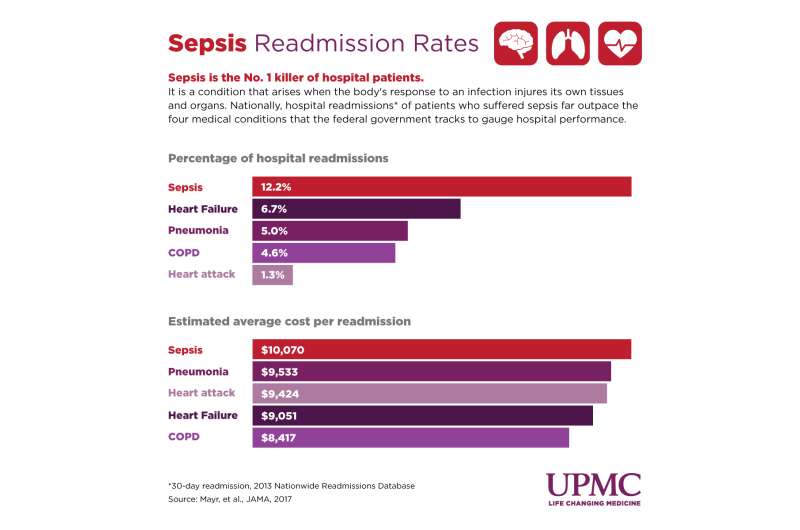Sepsis trumps CMS's four medical conditions tracked for readmission rates

Sepsis accounts for considerably more hospital readmissions and associated costs than any of the four medical conditions tracked by the federal government to measure quality of care and guide pay-for-performance reimbursements, according to an analysis led by the University of Pittsburgh School of Medicine and VA Pittsburgh Healthcare System.
The findings, published today in the Journal of the American Medical Association, highlight the need for coordinated efforts to develop new medical interventions aimed at improving sepsis outcomes and reducing readmissions.
Sepsis is the No. 1 killer of hospital patients and was defined last year by an international panel as a condition that arises when the body's response to an infection injures its own tissues and organs, sometimes progressing to septic shock. According to the National Institutes of Health, it may occur in more than 1 million U.S. patients every year, and—despite best practice—an estimated 28 to 50 percent of these people do not survive.
"Many people think infections and sepsis are short-term illnesses and that once patients are discharged from the hospital, they are better," said senior author Sachin Yende, M.D., M.S., associate professor in the Pitt School of Medicine's departments of Critical Care Medicine and Clinical and Translational Sciences and vice president of Critical Care at the VA Pittsburgh. "But all research to date shows that sepsis has serious, lingering consequences, and patients continue to have problems well after they are discharged."
The Centers for Medicare & Medicaid Services currently tracks readmissions for four medical conditions: heart attack, heart failure, chronic obstructive pulmonary disease (COPD) and pneumonia. A key component of the Affordable Care Act, the Hospital Readmission Reduction Program, penalizes hospitals if they have excessive rates of readmissions for these conditions.
Yende and his team analyzed data from the 2013 Nationwide Readmissions Database, which comprises 49 percent of U.S. inpatients, for the four conditions and sepsis. They revealed that sepsis accounts for 12.2 percent of readmissions, followed by 6.7 percent for heart failure, 5 percent for pneumonia, 4.6 percent for COPD and 1.3 percent for heart attack.
Sepsis also costs more. The estimated average cost per readmission for sepsis was $10,070, compared to $9,533 for pneumonia, $9,424 for heart attack, $9,051 for heart failure and $8,417 for COPD.
"This really puts in perspective how important sepsis is," said lead author Florian B. Mayr, M.D., M.P.H., faculty member in Pitt's Department of Critical Care Medicine and the Center for Health Equity Research and Promotion at the VA Pittsburgh. "If we, as a nation, place such high emphasis on reducing readmissions for the other four conditions, then we really need to look for opportunities to improve outcomes for sepsis, which has a higher rate of readmission than heart failure. People who survive an initial episode of sepsis often don't do well. They return to the hospital frequently, accrue new health conditions and have significantly elevated death rates."













